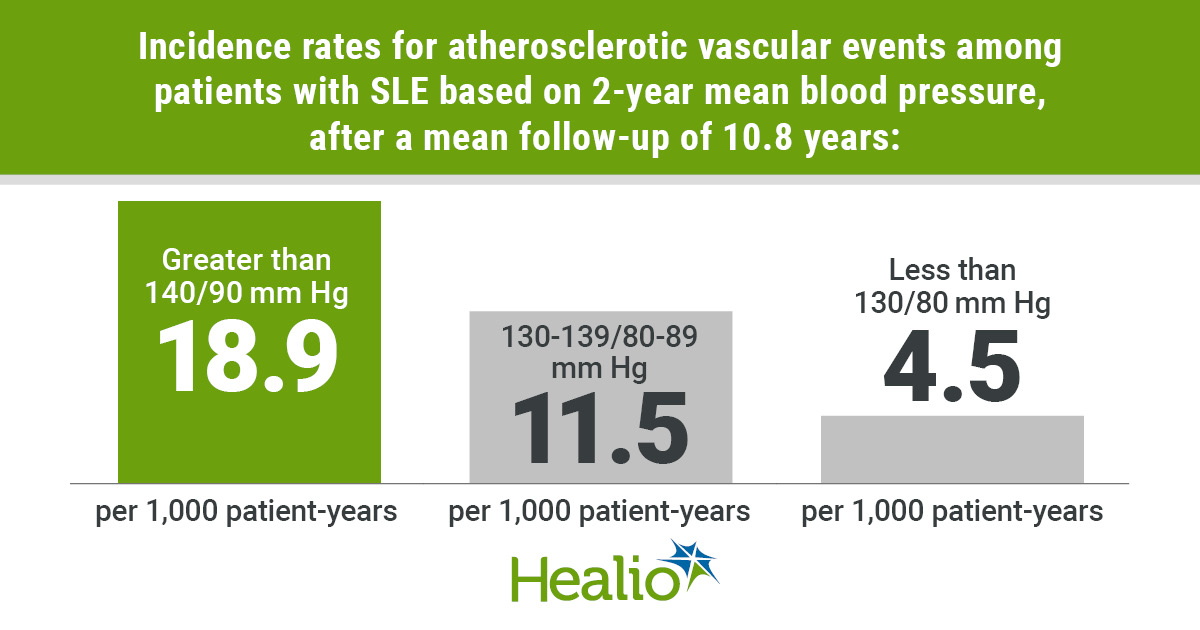New hypertension threshold linked to 73% higher risk for vascular events in lupus
A 2-year, sustained mean blood pressure of 130-139/80-89 mm Hg — now considered the threshold for stage 1 hypertension by the American College of Cardiology and the American Heart Association — is associated with a 73% higher risk for atherosclerotic vascular events among patients with lupus, according to data published in the Annals of the Rheumatic Diseases.
“The recently published guidelines for the management of arterial hypertension in adults by the American College of Cardiology/American Heart Association (ACC/AHA) recommended a significantly lower threshold of systolic and diastolic blood pressure (SBP, DBP) for diagnosis,” Konstantinos Tselios, MD, PhD, of the University of Toronto Lupus Clinic, and colleagues wrote. “The levels of 130-139mm Hg for SBP and 80-89mm Hg for DBP are now considered as stage 1 hypertension, in contrast to the previous recommendations in which hypertension was defined as BP 140/90mm Hg.”
“Patients with lupus have a fivefold increased lifetime risk for [atherosclerotic vascular events], while the relative risk is even higher in premenopausal women,” they added. “Therefore, proper management of hypertension is of paramount importance in SLE. However, on the basis of the recent guidelines, the patient with typical lupus (young female with no traditional atherosclerotic risk factors) would be considered as a low-risk individual and not offered treatment for a BP of 130–139/80–89 mm Hg. ... As such, the management of hypertension in lupus may be delayed, particularly at the levels of 130-139/80-89 mm Hg.”
To examine the impact of the new ACC/AHA hypertension definition on atherosclerotic vascular events in patients with systemic lupus erythematosus, Tselios and colleagues studied adults treated at the Toronto Lupus Clinic. Investigators categorized 1,532 patients with SLE and at least 2 years of follow-up, along with no prior atherosclerotic vascular events, into three groups based on mean blood pressure during that period. The groups were identified as 140/90mm Hg or greater (n = 155), 130-139/80-89 mm Hg (n = 316), and less than 130/80mm Hg (n = 1,061).

Participants were followed until the first atherosclerotic vascular event, defined as fatal or non-fatal coronary artery disease, cerebrovascular event or peripheral vascular disease, or last visit. The researchers compared the groups as per the baseline atherosclerotic risk factors, and performed a multivariable time-dependent analysis to adjust for the presence of other risk factors.
After a mean follow-up of 10.8 years, researchers documented 124 atherosclerotic vascular events. The incidence rates were 18.9 per 1,000 patient-years among patients greater than 140/90mm Hg, 11.5 in the 130-139/80-89 mm Hg group, and 4.5 among normotensive participants. Finally, a mean blood pressure of 130-139/80-89 mm Hg over the first 2years was independently associated with the occurrence of atherosclerotic vascular events (HR = 1.73; 95% CI, 1.13-2.65) (P = .011).
“Patients with lupus with an adjusted mean BP of 130-139/80-89 mm Hg over the first 2years from enrolment to the clinic had significantly higher incidence rates of [atherosclerotic vascular events] over more than 10 years of follow-up on average compared with normotensive individuals,” Tselios and colleagues wrote. “In a multivariable time-dependent analysis, this level of BP conferred a 73% higher risk for [atherosclerotic vascular events] after adjusting for other traditional and lupus-related risk factors. The management of hypertension in patients with lupus should commence early and aim at levels below 130/80mm Hg.” – by Jason Laday
Disclosure: The researchers report no relevant financial disclosures.
